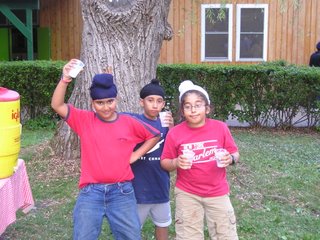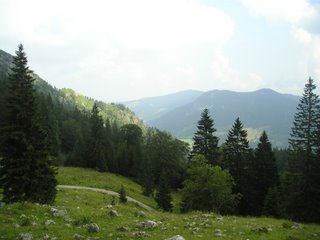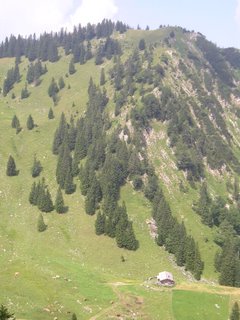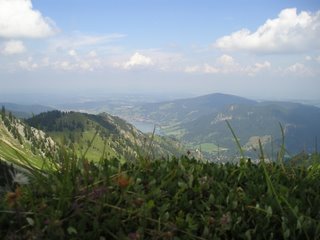The question was “How can one love creation and/or the Creator”. This was not a question for me to answer. It is a question that the mind (the entity that thinks) is asking itself. In the Guru Granth Sahib, Guru Nanak has addressed the mind and given example after example, and showered it with wise experience filled advice and observations. This poignant question and a hint at the answer is made clear by examples that only our great Master Nanak can be so thoughtful to, first of all, discern and then so eloquently explain.
I need not say more. I have done a meager job at transcreating this sabad. I hope I have kept to the original meaning and message. The only caution is the interchanging of the words “mind” and “heart”.
-------
How can the mind break away from the entanglements of non-Truth without the feeling and action of love? As a matter of fact, the hearts of those individuals whose minds are Guru-focused are filled with love in the form of total surrender to Vahiguru, and as a result, they are blessed with the virtues and attributes of Vahiguru. (Central idea – a question worth pondering!).
Oh mind, learn to love just like the lotus flower loves the water. Despite the tossing and tipping as a result of the turbulence of the waves in the pond, the lotus flower is full of grace and continues to share its beauty. If it wasn’t for the life giving water, the lotus would die and wither away. Such is the intense relationship of love that Vahguru has blessed the lotus and water
Oh mind, learn to love just like the fish loves water. The contentment of the fish is as full as the vastness of the body of water. That is, the more the water, the more the fish is content and alive. What fascinating relationship the fish has with water. Only Vahiguru knows the real depth of this relationship.
Oh mind, learn to love just like the catrik loves the rain. There may be oceans filled with water at the catrik’s disposal and the whole world is blossomed green as a result of the bodies of water, but until and unless the drops of water straight from the clouds up above don’t quench the thirst of the bird, it has no use of the other water. But alas, it is only through Grace that one can realize the intensity of the relationship we are to have with Vahiguru. Otherwise, we sow what we reap and our life continues on.
Oh mind, learn to love just like water loves pure milk. Water ends up mixing into the pure milk and the milk transforms the water into its own form. When a pot of the milk-water mix is put to boil, the water takes all the heat. It doesn’t let the milk burn of heat. Similar is the relationship of creations with the Creator. Vahguru provides a union to the wandering mind and blesses the realization of Truth.
Oh mind, learn to love just like the cakvī loves the sun. After the sun sets at night, it does not sleep even for an instant and considers the sun to be close at hand. The experience of this feeling does not arise within those people that are individually focused, whereas the Guru-inspired person always feels the omnipresence of Vahiguru.
Oh mind, think about this: The individually focused person focuses on praising oneself for accomplishments, but the Creator is responsible for what goes on. No matter how hard one tries, one cannot completely fathom the vastness of the Creator. This vastness is understood and satisfaction is gained only by submitting to the wisdom of the Guru.
Oh mind, think about this: The bond of action-filled love for truth is only sustained by the Satiguru. Through the grace of the Satiguru one develops a deep relationship with Nam-Vahiguru who is the sustainer of the complete universe. If one becomes a customer of the virtues of Vahiguru, then the pure Nam relationship is further developed.
Oh mind, imagine the people of the world to be birds. They fly into this world, feed on their grain and seeds, and then depart from this world. It is like a game and all that arrive into the play field must eventually depart within a short period of time. Understand that the success factor of time spent on life is a matter of Grace. Focus on making the most of your time in the play field.
Oh mind, understand that without the Guru love does not manifest because individualistic effort inspired by haumai is impossible to conquer on your own. When the intuitive understanding is formed as a result of imbibing the meaning of the sabad (Infinite Wisdom), then one realizes that the self and Vahiguru are a merged entity. Only the Guru-inspired individuals can introspect and realize the self. The individualistic inspired individuals can try all they want, they will never succeed in self-realization.
Oh mind, those that have created a strong relationship with the sabad (Infinite Wisdom), they never have to suffer the frustration of separation. Those that follow an individualistic mindset are doomed to suffer separation because they have not understood the Guru-inspired concept of love. Nanak emphasizes the fact that once inspired by the Guru, the individual feels, sees and experiences no difference between the self and Vahiguru.
Revealed by Guru Baba Nanak in Siri Rag, Page 60 of Sri Guru Granth Sahib
-------
ਸਿਰੀ ਰਾਗੁ ਮਹਲਾ 1 ॥
ਰੇ ਮਨ, ਐਸੀ ਹਰਿ ਸਿਉ ਪ੍ਰੀਤਿ ਕਰਿ, ਜੈਸੀ ਜਲ ਕਮਲੇਹਿ ॥
ਲਹਰੀ ਨਾਲਿ ਪਛਾੜੀਐ ਭੀ ਵਿਗਸੈ ਅਸਨੇਹਿ ॥
ਜਲਿ ਮਹਿ ਜੀਅ ਉਪਾਇ ਕੈ ਬਿਨੁ ਜਲ ਮਰਣੁ ਤਿਨੇਹਿ ॥1॥
ਮਨ ਰੇ, ਕਿਉ ਛੂਟਹਿ ਬਿਨੁ ਪਿਆਰ ॥ ਗੁਰਮੁਖਿ ਅੰਤਰਿ ਰਵਿ ਰਹਿਆ ਬਖਸੇ ਭਗਤਿ ਭੰਡਾਰ ॥1॥ਰਹਾਉ॥
ਰੇ ਮਨ, ਐਸੀ ਹਰਿ ਸਿਉ ਪ੍ਰੀਤਿ ਕਰਿ, ਜੈਸੀ ਮਛੁਲੀ ਨੀਰ ॥
ਜਿਉ ਅਧਿਕਉ ਤਿਉ ਸੁਖੁ ਘਣੋ ਮਨਿ ਤਨਿ ਸਾਂਤਿ ਸਰੀਰ ॥
ਬਿਨੁ ਜਲ ਘੜੀ ਨ ਜੀਵਈ ਪ੍ਰਭੁ ਜਾਣੈ ਅਭ ਪੀਰ ॥2॥
ਰੇ ਮਨ, ਐਸੀ ਹਰਿ ਸਿਉ ਪ੍ਰੀਤਿ ਕਰਿ, ਜੈਸੀ ਚਾਤ੍ਰਿਕ ਮੇਹ ॥
ਸਰ ਭਰਿ ਥਲ ਹਰੀਆਵਲੇ ਇਕ ਬੂੰਦ ਨ ਪਵਈ ਕੇਹ ॥
ਕਰਮਿ ਮਿਲੈ ਸੋ ਪਾਈਐ ਕਿਰਤੁ ਪਇਆ ਸਿਰਿ ਦੇਹ ॥3॥
ਰੇ ਮਨ, ਐਸੀ ਹਰਿ ਸਿਉ ਪ੍ਰੀਤਿ ਕਰਿ, ਜੈਸੀ ਜਲ ਦੁਧ ਹੋਇ ॥
ਆਵਟਣੁ ਆਪੇ ਖਵੈ ਦੁਧ ਕਉ ਖਪਣਿ ਨ ਦੇਇ ॥
ਆਪੇ ਮੇਲਿ ਵਿਛੁੰਨਿਆ ਸਚਿ ਵਡਿਆਈ ਦੇਇ ॥4॥
ਰੇ ਮਨ, ਐਸੀ ਹਰਿ ਸਿਉ ਪ੍ਰੀਤਿ ਕਰਿ, ਜੈਸੀ ਚਕਵੀ ਸੂਰ ॥
ਖਿਨੁ ਪਲੁ ਨੀਦ ਨ ਸੋਵਈ ਜਾਣੈ ਦੂਰਿ ਹਜੂਰਿ ॥
ਮਨਮੁਖਿ ਸੋਝੀ ਨਾ ਪਵੈ ਗੁਰਮੁਖਿ ਸਦਾ ਹਜੂਰਿ ॥5॥
ਮਨਮੁਖਿ ਗਣਤ ਗਣਾਵਣੀ ਕਰਤਾ ਕਰੇ ਸੁ ਹੋਇ ॥
ਤਾ ਕੀ ਕੀਮਤਿ ਨ ਪਵੈ ਜੇ ਲੋਚੈ ਸਭੁ ਕੋਇ ॥
ਗੁਰਮਤਿ ਹੋਇ ਤ ਪਾਈਐ ਸਚਿ ਮਿਲੈ ਸੁਖੁ ਹੋਇ ॥6॥
ਸਚਾ ਨੇਹੁ ਨ ਤੁਟਈ ਜੇ ਸਤਿਗੁਰੁ ਭੇਟੇ ਸੋਇ ॥
ਗਿਆਨ ਪਦਾਰਥੁ ਪਾਈਐ ਤ੍ਰਿਭਵਣ ਸੋਝੀ ਹੋਇ ॥
ਨਿਰਮਲੁ ਨਾਮੁ ਨ ਵੀਸਰੈ ਜੇ ਗੁਣ ਕਾ ਗਾਹਕੁ ਹੋਇ ॥7॥
ਖੇਲਿ ਗਏ ਸੇ ਪੰਖਣੂੰ ਜੋ ਚੁਗਦੇ ਸਰ ਤਲਿ ॥
ਘੜੀ ਕਿ ਮੁਹਤਿ ਕਿ ਚਲਣਾ ਖੇਲਣੁ ਅਜੁ ਕਿ ਕਲਿ ॥
ਜਿਸੁ ਤੂੰ ਮੇਲਹਿ ਸੋ ਮਿਲੈ ਜਾਇ ਸਚਾ ਪਿੜੁ ਮਲਿ ॥8॥
ਬਿਨੁ ਗੁਰ, ਪ੍ਰੀਤਿ ਨ ਉਪਜੈ ਹਉਮੈ ਮੈਲੁ ਨ ਜਾਇ ॥
ਸੋਹੰ ਆਪੁ ਪਛਾਣੀਐ ਸਬਦਿ ਭੇਦਿ ਪਤੀਆਇ ॥
ਗੁਰਮੁਖਿ ਆਪੁ ਪਛਾਣੀਐ ਅਵਰ ਕਿ ਕਰੇ ਕਰਾਇ ॥9॥
ਮਿਲਿਆ ਕਾ ਕਿਆ ਮੇਲੀਐ ਸਬਦਿ ਮਿਲੇ ਪਤੀਆਇ ॥
ਮਨਮੁਖਿ ਸੋਝੀ ਨਾ ਪਵੈ ਵੀਛੁੜਿ ਚੋਟਾ ਖਾਇ ॥
ਨਾਨਕ ਦਰੁ ਘਰੁ ਏਕੁ ਹੈ ਅਵਰੁ ਨ ਦੂਜੀ ਜਾਇ ॥10॥11॥


















 A family friend of ours gets tapped for one of 35 Young Innovators of the Year by MIT's Technology Review magazine which is a popular cutting edge technology power magazine! Great to see him make so much progress in such little time, and another sabat surat in the technology field.
A family friend of ours gets tapped for one of 35 Young Innovators of the Year by MIT's Technology Review magazine which is a popular cutting edge technology power magazine! Great to see him make so much progress in such little time, and another sabat surat in the technology field.


















